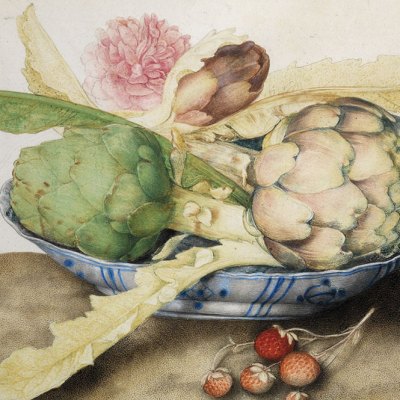In 1715, in a field near the village of Legnaia, 180 stems of wheat were found to have grown from a single seed. So unusual was this that the landowner, the Grand Duke Cosimo III de’ Medici ordered his court artist Bartolomeo Bimbi to paint these meraviglie naturae. Bimbi, already known for his detailed baroque paintings of fruit and vegetables, would give the sheaf centre stage in the picture, much as a court painter might portray a noble person.
However, this subject was no simple curiosity picture. With its powerful anthropomorphic undertones, Bimbi’s rendition did not just symbolise the glory of nature and the richness of divine creation. It was also intended to remind viewers that Medici was their Christian prince and overall godly caretaker of nature.
Tulip with butterfly and June bug (c. 1730), Barbara Regina Dietzsch. Hamburger Kunsthalle.
Photo: Christoph Irrgang; © Hamburger Kunsthalle/bpk

Bimbi’s work is one of many layered stories that can be unearthed in ‘Botanical: Observing Beauty’ at the Beaux-Arts de Paris, an exhibition filled with around 400 botanical wonders covering 5,000 years of art, mostly from the Western hemisphere. They range from the ancient – including an incredible Greek gold funerary laurel wreath dating from 325 BC – to the contemporary, such as Eva Jospin’s large yet intricate cardboard forest.
Among the works on display we find Dom Robert’s stunning tapestry of a marine underworld Mermaid Garden (1961), Émile Gallé’s delicate drawing Squashes and Wasps (undated) that reminds us of Gallé’s status as artist-botanist, Séraphine de Senlis’s botanically accurate Cluster of Grapes (c. 1930), Otto Dix’s Irises (c. 1912) painted as single stems laid out as if on a mortician’s table and Barbara Regina Dietzsch’s hyperreal Tulip with butterfly and June bug (c. 1730).
The selections of curator-botanist Marc Jeanson and assistant curator Raphaelle Reynaud make visible how art and science have co-existed. As such, the most engaging artworks in the exhibition are those that go beyond the purely decorative. Bimbi was particularly good at this, as his other work in the show – Giant Carnations (1699) – suggests. The two flowers loom large in the picture, but neither touch nor face each other, like melancholic lovers doomed to suffer. Bimbi, like Dix, Gustave Caillebotte, Brassaï, Robert Mapplethorpe, Leendert Blok, Joseph Sudek, Victoria Braithwaite and others within the exhibition all instinctively understood how to use the natural world to reflect the shifting and unpredictable state of the human mind.
Giant Carnations (1699), Bartolomeo Bimbi. Photo: © Museo della Natura Morta, Poggio a Caiano. Su concessione del Ministero della Cultura – Direzione regionale Musei della Toscana – Firenze

Things are more straightforward when it comes to jewellery. Chaumet, the initiators of this exhibition, have solid connections with works in the show that date back to the late 18th century. Marie-Étienne Nitot (1750–1809), the official jeweller to the Emperor Napoleon and the founder of the House of Chaumet, was greatly inspired by the natural world and described himself as the ‘naturalist jeweller’. His close ties to Empress Josephine (who also had a big interest in botany) meant that pieces were commissioned by and for her. Over time, there would be certain plants – wheat, laurel, lily – that would become symbolic for the jewellery house, some of which are represented in this exhibition alongside work by other jewellers.
The exhibition makes little mention of climate change or the devastating effect of human interference with the natural world, but it doesn’t need to. We know what the problems are and what we need to do. Artists and scientists will continue to explore, with intense observation and insight, the interconnectedness that we should feel with all the living things that surround us.
‘Botanical: Observing Beauty’ is at the Beaux-Arts de Paris until 4 September.



